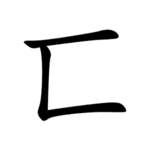| 匸 | ||
|---|---|---|
| ||
| 匸 (U+5338) "hiding enclosure" | ||
| Pronunciations | ||
| Pinyin: | xì | |
| Bopomofo: | ㄒㄧˋ | |
| Gwoyeu Romatzyh: | shih | |
| Wade–Giles: | hsi4 | |
| Cantonese Yale: | hái | |
| Jyutping: | hai2 | |
| Japanese Kana: | ケイ kē (on'yomi) かくす kakusu (kun'yomi) | |
| Sino-Korean: | 혜 hye | |
| Names | ||
| Chinese name(s): | 區字框/区字框 qūzìkuàng | |
| Japanese name(s): | 隠構/匸構/かくしがまえ kakushigamae | |
| Hangul: | 감출 gamchul | |
| Stroke order animation | ||
 | ||
Radical 23 or radical hiding[1] enclosure (匸部) is one of the 23 Kangxi radicals (214 radicals total) composed of two strokes.
In the Kangxi Dictionary, there are 17 characters (out of 49,030) to be found under this radical.
In Traditional Chinese used in Taiwan, Hong Kong and Macau, radical 23 (hiding enclosure, 匸), whose second stroke starts is a bit right to the starting point of the first stroke, is slightly different from radical 22 (right open box, 匚).'
In mainland China, radical 22 and 23 were unified as right open box 匚, and the nuance, as well as radical hiding enclosure, no longer exists in Simplified Chinese characters. This merger also applies to Traditional Chinese characters in China's GB character set.
A similar merger was also made in Japanese kanji, including their kyūjitai forms in JIS X 0208 character set. Some Japanese dictionaries keep the two radicals in their indexes, but they both lead to the same merged radical.[2]
- ^ Yamada, Michio; Kurihara, Hiroki; Suzuki, Mitsuaki; Saito, Masayoshi; Slanina, Zdenek; Uhlik, Filip; Aizawa, Toshihiro; Kato, Tatsuhisa; Olmstead, Marilyn M.; Balch, Alan L.; Maeda, Yutaka; Nagase, Shigeru; Lu, Xing; Akasaka, Takeshi (2015-01-14). "Hiding and Recovering Electrons in a Dimetallic Endohedral Fullerene: Air-Stable Products from Radical Additions". Journal of the American Chemical Society. 137 (1): 232–238. doi:10.1021/ja509956y. ISSN 0002-7863. PMID 25494409.
- ^ Examples include 新明解現代漢和辞典 Shin Meikai Gendai Kanwa Jiten published by Sanseidō. While its index lists both radicals, they both lead to the same merged radical. Characters that formerly belonged to radical 23 are listed orthodox kyūjitai forms (e.g. 區) under their entries (e.g. 区), while their JIS kyūjitai forms (e.g. 區) are treated as "alternative forms" (別体字 betsutaiji).